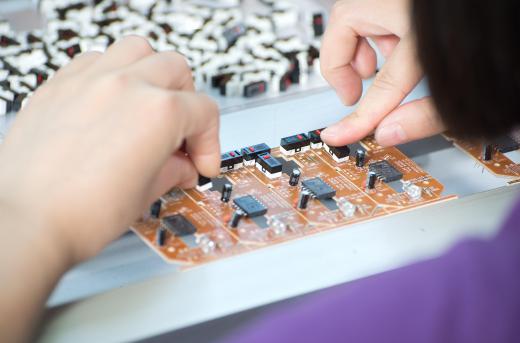Depaneling is a manufacturing practice used with printed circuit boards (PCBs) in which one large PCB is made using several smaller PCBs, after which the large PCB is sectioned, or depaneled. This practice makes it easer to produce a high volume of PCBs, because machines can work on several PCBs at once, disguised as one large PCB. The depaneling will occur during some part of the manufacturing process, after all the components are placed on the board, after the circuits are tested or before packaging. There are six major ways to depanel a PCB; people do some, and others are entirely machine based.
When a large number of PCBs needs to be made, depaneling will often be used to increase productivity. It starts with one large PCB, known as a multiblock. On this multiblock, several smaller PCBs will be put together. The machines putting the PCB together think they are producing one PCB, when really it is several boards at once.

When the multiblock is finished, it needs to be separated, or depaneled. If the multiblock is not depaneled, there is no way a single user can utilize the entire multiblock, because it would not fit into a conventional computer. To help with depaneling, grooves may be made in the multiblock to separate the smaller PCBs, depending on the extraction method.
There are six major techniques for depaneling the multiblock. In the hand-break method, a groove is made for each PCB and a worker breaks the PCB against the groove line by hand. The V-cut technique uses a large, rotary blade that cuts into the groove; this technique is cheap, because the blade costs very little and needs only to be sharpened on occasion. Punching uses a two-part apparatus to punch out the small PCBs; one part has blades for cutting into the multiblock, while the second part has supports to separate the blocks.
With the router technique, a router bit is used to drill through the multiblock; this is best for PCBs with sharp angles, but it has a low throughput. The saw method is similar to the rotary method, but this can cut through the multiblock even if there is not a groove present. Laser separation uses an ultraviolet (UV) laser to quickly cut through the multiblock with precision.
Multiblock depaneling will occur at some point during the manufacturing process, but this point can be at nearly any stage. It can be separated during the circuit tests, the circuit soldering, before packaging and assembly, or right after the surface pieces are mounted. This usually depends on the manufacturer’s preference but also may depend on what type of parts is used in the PCB.
